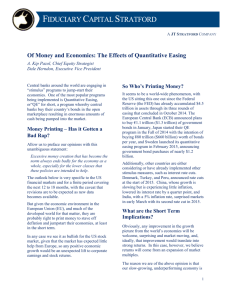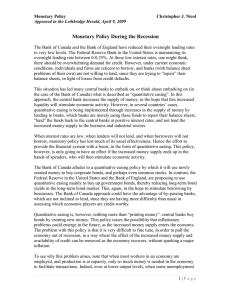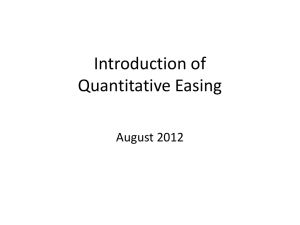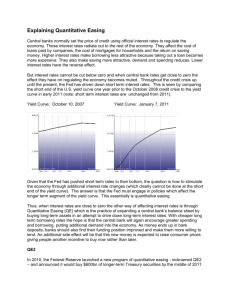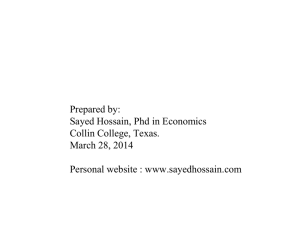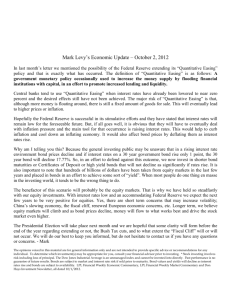Advances in Management & Applied Economics, vol. 5, no.2, 2015,... ISSN: 1792-7544 (print version), 1792-7552(online)
advertisement
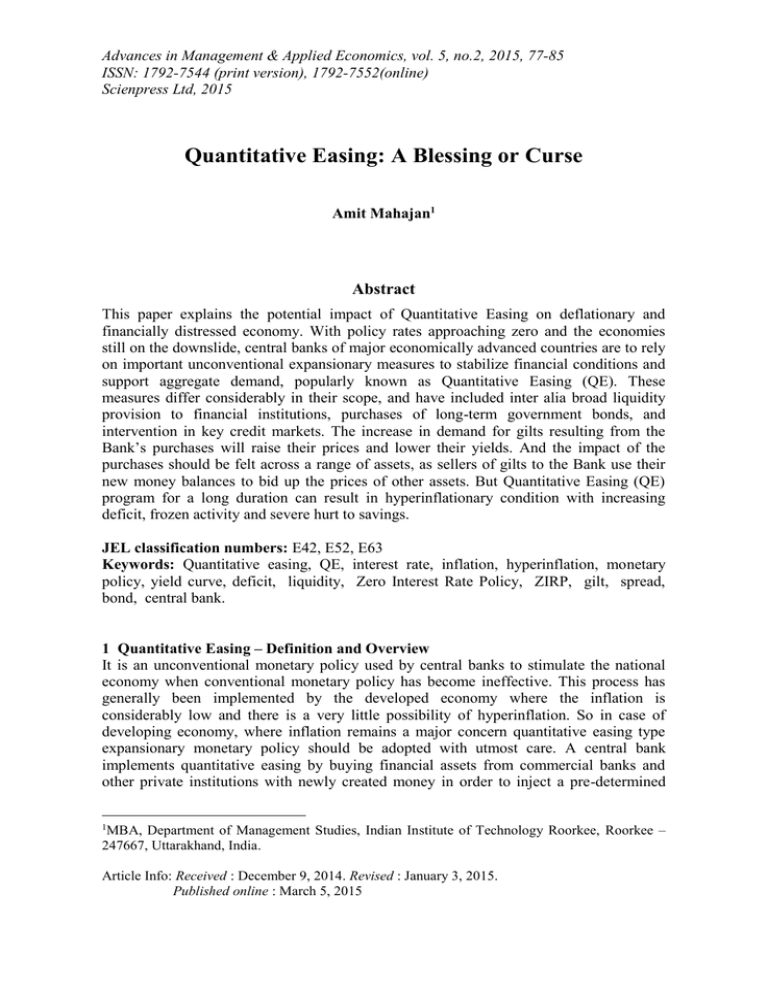
Advances in Management & Applied Economics, vol. 5, no.2, 2015, 77-85 ISSN: 1792-7544 (print version), 1792-7552(online) Scienpress Ltd, 2015 Quantitative Easing: A Blessing or Curse Amit Mahajan1 Abstract This paper explains the potential impact of Quantitative Easing on deflationary and financially distressed economy. With policy rates approaching zero and the economies still on the downslide, central banks of major economically advanced countries are to rely on important unconventional expansionary measures to stabilize financial conditions and support aggregate demand, popularly known as Quantitative Easing (QE). These measures differ considerably in their scope, and have included inter alia broad liquidity provision to financial institutions, purchases of long-term government bonds, and intervention in key credit markets. The increase in demand for gilts resulting from the Bank’s purchases will raise their prices and lower their yields. And the impact of the purchases should be felt across a range of assets, as sellers of gilts to the Bank use their new money balances to bid up the prices of other assets. But Quantitative Easing (QE) program for a long duration can result in hyperinflationary condition with increasing deficit, frozen activity and severe hurt to savings. JEL classification numbers: E42, E52, E63 Keywords: Quantitative easing, QE, interest rate, inflation, hyperinflation, monetary policy, yield curve, deficit, liquidity, Zero Interest Rate Policy, ZIRP, gilt, spread, bond, central bank. 1 Quantitative Easing – Definition and Overview It is an unconventional monetary policy used by central banks to stimulate the national economy when conventional monetary policy has become ineffective. This process has generally been implemented by the developed economy where the inflation is considerably low and there is a very little possibility of hyperinflation. So in case of developing economy, where inflation remains a major concern quantitative easing type expansionary monetary policy should be adopted with utmost care. A central bank implements quantitative easing by buying financial assets from commercial banks and other private institutions with newly created money in order to inject a pre-determined MBA, Department of Management Studies, Indian Institute of Technology Roorkee, Roorkee – 247667, Uttarakhand, India. 1 Article Info: Received : December 9, 2014. Revised : January 3, 2015. Published online : March 5, 2015 78 Amit Mahajan quantity of money into the economy. This is distinguished from the more usual policy of buying or selling government bonds to keep market interest rates at a specified target value. Quantitative easing increases the size of the balance sheet of the central bank through an increase of its monetary liabilities (base money), holding constant the composition of its assets i.e. constant (average) liquidity and riskiness of its asset portfolio. Asset composition can be defined as the proportional shares of the different financial instruments held by the central bank in the total value of its assets. This raises the prices of the financial assets bought, which lowers their corresponding yield. Expansionary monetary policy typically involves the central bank buying short-term government bonds in order to lower short-term market interest rates. However, when short-term interest rates are either at, or close to, zero, normal monetary policy can no longer lower interest rates. Such a situation, in which the nominal rate hits its zero lower bound, is popularly known as “liquidity trap”. The presumption is that real interest rates (r), not nominal interest rates (i ), are what mainly matter for, say, aggregate demand. In deep recessions, monetary policymakers may need to push real rates (r = i – π, where π is the rate of inflation) into negative territory. But once i hits zero, the central bank cannot force it down any farther, which leaves r stuck at –π, which is small or possibly even positive. In any case, once i = 0, conventional monetary policy becomes ineffective. Quantitative easing may then be used by the monetary authorities to further stimulate the economy by purchasing assets of longer maturity than only short-term government bonds, and thereby lowering longer-term interest rates further out on the yield curve. So the goal of this policy is to increase the money supply rather than to decrease the interest rate, which cannot be decreased further. This is often considered a last resort to stimulate the economy. Central banks have adequate tools to effect orderly exit from exceptional monetary policy actions, but clear communication is central to maintaining well anchored inflation expectations and to ensuring a smooth return to normal market functioning. 2 Quantitative Easing: Comparison Unconventional Monetary Policy with other Expansionary Qualitative Easing: Unlike Quantitative Easing, it is a shift in the composition of the assets of the central bank towards less liquid and riskier assets, holding constant the size of the balance sheet (and the official policy rate and the rest of the list of usual suspects). The less liquid and more risky assets can be private securities as well as sovereign or sovereign guaranteed instruments. All forms of risk, including credit risk (default risk) are included. Credit Easing: Credit easing involves increasing the money supply by the purchase not of government bonds, but of private sector assets such as corporate bonds and residential mortgage-backed securities. When undertaking credit easing, the central banks increase the money supply not by buying government debt, but instead by buying private sector assets including residential mortgage-backed securities. These purchases increased the monetary base in a way similar to a purchase of government securities. Quantitative Easing: A Blessing or Curse 79 Printing money: Quantitative easing has been popularly described as printing money by some representatives of the media, central bankers and financial analysts. However the use of newly created money is different in QE. With QE, the newly created money is used for buying government bonds or other financial assets, whereas the term printing money usually implies that the newly minted money is used to directly finance government deficits or pay off government debt (also known as monetizing the government debt). Central banks in most developed nations (e.g. UK, US, Japan, and EU) are forbidden by law to buy government debt directly from the government and must instead buy it from the secondary market. This multi-step process, where the government sells bonds to private entities which the central bank then buys, has been called "monetizing the debt" by some analysts. 3 Experience of Quantitative Easing: Examples from Developed Economies Japan’s experience in 1999–2006 provides the prime case study of unconventional measures. Following a bout of deflation, the Bank of Japan (BoJ) introduced in early 1999 the Zero Interest Rate Policy (ZIRP), committing to keeping the interbank overnight rate at zero until deflationary situations are dispelled. After a brief recovery of the economy, which pushed year-on-year change in core CPI above zero for just one month, the BoJ lifted ZIRP in August 2000. However, the collapse of the dot-com bubble and slowdown of the world economy made another recession a possibility. As the overnight rate was still close to zero despite the exit from ZIRP, the BoJ had to take extraordinary measures. On March 19, 2001, it introduced a Quantitative Easing Policy (QEP) and simultaneously committed to keeping the policy rate at zero until the core Consumer Price Index (CPI) registers stably a zero percent or an increase year on year. A key feature of that approach was targeting the amount of excess reserves of commercial banks, primarily by buying government securities and most commentators equate this feature with QEP. The BoJ’s quantitative easing set a target on bank reserves at the BoJ at around 5 trillion yen. In addition, the BoJ also announced that it would increase the amount of its outright purchases of long-term Japanese government bonds. The BoJ subsequently increased its target for reserves to 30-35 trillion yen before terminating QEP on March 9, 2006. In addition, the BoJ supported lending through special operations to facilitate corporate financing. 80 Amit Mahajan Figure 1 Figure 2 After QEP officially ended, the BoJ was able to reduce the size of its balance sheet and excess reserves fairly quickly, although not all the way to its late - 1990s level. It curtailed sharply its funds-supplying operations and started gradually to reduce its holdings of government securities. It also began slowly to divest stocks acquired—on a fairly small scale. Monetary Policy Committee (MPC) of Bank of England undertook quantitative easing (QE) policy from March 2009 to January 2010. The MPC of the Bank of England reduced Bank Rate, the official UK policy rate, to 0.5% on 5 March 2009. But despite reducing interest rates to their effective lower bound, the MPC felt that additional measures were Quantitative Easing: A Blessing or Curse 81 necessary to achieve the 2% Consumer Price Index (CPI) inflation target in the medium term. The aim of the program of asset purchases was to inject a large monetary stimulus into the economy, in order to boost nominal expenditure and thereby increase domestic inflation sufficiently to meet the inflation target. Between March 2009 and the end of January 2010 the Bank purchased a total of £200 billion assets, an amount equivalent to about 14% of UK’s Gross Domestic Product (GDP). Figure 3 Source: Working Paper No. 393, the financial market impact of quantitative easing, Bank of England 4 Positive Impact of Quantitative Easing on existing deflationary economy: 4.1 Gilt market reactions Since Gilts made up the majority of the asset purchases, the most pronounced impact of QE on economy comes by the way through gilts; both through (i) yields/prices and (ii) liquidity. 82 Amit Mahajan 4.1.1 Movements in yields Both gilt yields and gilt-OIS (Overnight Index Swap) spreads fall after QE becomes functional which are quite obvious. In order to get an estimate of the effect of the QE announcements on gilt yields, we could simply sum over those various reactions to QE news. But to get a more precise picture of the overall impact on the term structure, it is necessary to strip out coupons from each gilt which allows us to construct continuous curves i.e. estimated zero-coupon yield curves. The argument above can be demonstrated by the example of Bank of England as displayed in Figs. below: Figure 4: QE announcement impact on gilt yields, OIS Figure 5: Total QE announcement impact and sensitivity and gilt-OIS spreads: average change in 5-25 to window size by Bank of England year spot rates by Bank of England 4.1.2 Impact on liquidity and turnover Asset Purchase Facility (APF) purchases of gilts may have an impact on the gilt market by improving liquidity. 4.2 Reaction of Other Assets As money is not a perfect substitute for gilts, it is expected that investors tend to reduce their money holdings associated with QE purchases by buying other currency assets, such as corporate bonds and equities, and foreign assets. This will likely put upwards pressure on the prices of those assets, and perhaps downward pressure on the respective currency exchange rate. In addition, announcements about QE may contain information about the economy that has implications for perceptions of future corporate earnings and the uncertainty around them; and changes in the prices of gilts may affect the rate at which investors discount future cash flows. Both of these effects will also have an impact on asset prices. 4.2.1 Impact on Prices The expectations and actual purchases of gilts by the Asset Purchase Facility (APF) are likely to have had an impact on other asset prices via the macro/policy news. Generally, Quantitative Easing: A Blessing or Curse 83 the equity and corporate bond prices react in a less uniform way than gilts after the announcement of QE. 4.2.1.1 Corporate bonds Lower gilt yields should lead to lower corporate bond yields for a given spread. But, in addition, as investors rebalance their portfolios away from gilts and into corporate bonds the component of that spread representing compensation for risk-aversion and uncertainty should fall reducing yields further, though this could take some more time. 4.2.1.2 Equities Lower gilt yields should, all else equal, increase the present value of future dividends, thus raising equity prices. In addition, as investors rebalance their portfolios away from gilts towards more risky assets, the additional compensation investors demand for the risk of holding equities (so-called equity risk premium) should fall. This will put further upward pressure on equity prices, though again this could take time to come through. 4.2.1.3 Currency Lower gilt yields should, all else equal, lead to a depreciation of respective currency. A standard Uncovered Interest Parity (UIP) decomposition can predict an depreciation given the observed fall in spot gilt yields over the QE news events e.g. summing over the immediate reactions to the six QE news announcements, the sterling ERI depreciated by 4.0% overall as depicted in Fig. below: Figure 6 4.2.1.4 Impact on liquidity and issuance All else being equal, higher equity and corporate bond prices are likely to encourage firms to raise finance through relatively higher capital market issuance either in addition to or as a substitute for other forms of funding. 84 Amit Mahajan 5 Potential Drawbacks of Quantitative Easing 5.1 Galloping Inflation The first potential danger is that quantitative easing increases the likelihood that long-run inflation could increase well above the target inflation objective. Because with the excess reserves in banks, a massive increase in the money supply through significant increase in their lending or investing could create a galloping inflationary scenario. 5.2 Savers are Hurting The yield on the Treasury note reduces drastically as compared to that when economic growth is much more robust and demand for treasuries is much lower. Many older investors depend on the income they receive from their investments in high quality bonds like treasuries, and faced with paltry Treasury yields, many are considering whether they should take on more risk. Rates can only move higher, and when they do, investors that have moved farther down the duration scale (a measure of interest-rate sensitivity) will feel the pain. When interest rates rise, the price of bonds falls—and longer duration bonds will be hit harder than others. 5.3 Add to the deficit By buying up more assets, the central bank is essentially printing more money and adding to the already ballooning deficit. The biggest holders of these treasuries are banks, so the central bank is effectively putting the cash into the banks and taking the treasuries off the banks' books. While the central bank could force down Treasury bond yields temporarily by creating a temporary scarcity of long-duration Treasury securities, it would do so at the cost of higher Treasury bond yields in future years, when rising Treasury debt will need to be permanently financed. 5.4 Activity is frozen When the central bank doesn't plan on raising rates for an extended period, it is implied that there's a good chance the situation won't change much in the short term. It basically halts activity because if anticipated rates go down in the future, there's no incentive to do anything now. Another reason for concern is that employment growth is uncharacteristically slow during recovery. 6 Conclusion A combination of a major deflationary shock and financial market distress force central banks to cut policy rates to near zero and engage in unconventional monetary policy. Such measures include commitment to keeping interest rates low for an extended period of time. Massive asset purchases boost the size of the central bank balance sheets. Central bank interventions, along with government actions, are needed in stabilizing financial conditions over time. Ample liquidity provision helps to avoid a meltdown in the financial Quantitative Easing: A Blessing or Curse 85 system. Direct support to borrowers and investors in disrupted markets is necessary to alleviate pressure and propping demand. However, unwinding unconventional measures will not be an easy task, and it requires a sensible plan, skillful execution, and clear communication. ACKNOWLEDGEMENTS: I thank my advisors, Dr. J. P. Singh and Dr. Usha Lenka of Department of Management Studies, Indian Institute of Technology Roorkee, India for their guidance and support. All errors are my own. References [1] Joyce Michael, Lasaosa Ana, Stevens Ibrahim and Tong Matthew. The Financial Impact of Quantitative Easing. Working Paper no. 393, (2010). Available at SSRN: http://ssrn.com/abstract=1638986 or http://dx.doi.org/10.2139/ssrn.1638986. [2] Klyuev Vladimir, Imus Phil de and Srinivasan Krishna. Unconventional Choices for Unconventional Times: Credit and Quantitative Easing for Advanced Economies. IMF Staff Position Note SPN/09/27, (2009). [3] Yousefi Mehrdad. A Walk Through the Pros and Cons of Quantitative Easing. Mortgage Strategy, Centaur Communications Limited, (2012), p.32 (ISSN: 1475651X). [4] Thornton Daniel. L The Downside of Quantitative Easing. Economic Synopses; no. 34, (2010), http://research.stlouisfed.org/publications/es/10/ES1034.pdf. [5] Kapetanios George, Mumtaz Haroon, Stevens Ibrahim and Theodoridis Konstantinos. Assessing the Economy-Wide Effects of Quantitative Easing. Working Paper no. 443, (2012). Bank of England. [6] Blinder Alan S. Quantitative Easing: Entrance and Exit Strategies. Federal Reserve Bank of St. Louis Review, 92 (6), (2010), 465 – 479. [7] Baden Ben.Why More Quantitative Easing Could Be a Mistake. U.S News and World Report LP, (2010), http://money.usnews.com/money/business- economy/articles/2010/10/13/why-morequantitative-easing-could-be-a-mistake. [8] Kurihara Yutaka. Recent Japanese Monetary Policy: An Evaluation of the Quantitative Easing. International Journal of Business, 11(1), (2006), (ISSN: 10834346). [9] Quantitative Easing – Wikipedia, the Free Encyclopedia as accessed on 11.10.2012. [10] Joyce Michael A. S, Lasaosa Ana, Stevens Ibrahim and Tong Matthew. The Financial Market Impact of Quantitative Easing in the United Kingdom. International Journal of Central Banking, Volume 7, No. 3, (2011), 113 - 161.

